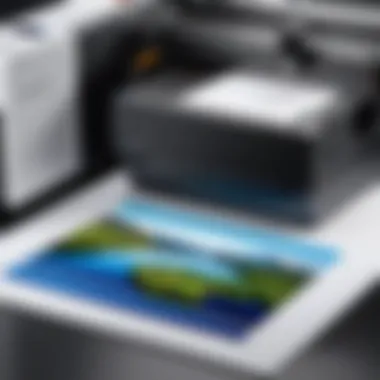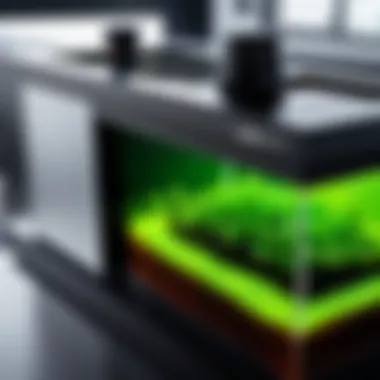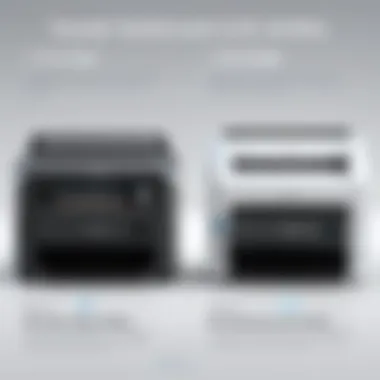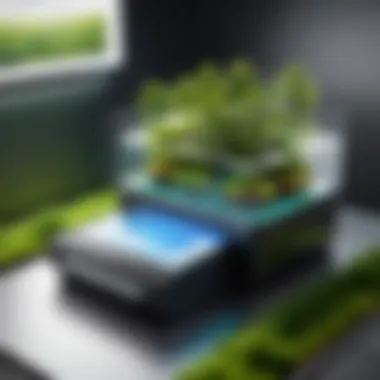Exploring Eco Tank Printers for 13x19 Printing


Intro
As the demand for high-quality printing continues to grow in both personal and professional settings, eco tank printers have emerged as a noteworthy option for users seeking efficiency and sustainability. In particular, the ability to print on large-format paper, such as 13x19 inches, enhances the versatility of these printers. This article aims to provide a comprehensive exploration of eco tank printers that support this size, shedding light on their technical specifications, performance metrics, and practical applications.
Whether you are a photographer, graphic designer, or simply someone who appreciates larger prints, understanding these devices is crucial. The eco tank printer's unique design, featuring refillable ink tanks rather than conventional cartridges, offers significant advantages in terms of both cost-effectiveness and environmental impact. This exploration will cover various aspects of the printers, including key features, comparisons with traditional models, and insights into usability across different contexts.
Intro to Eco Tank Printers
In recent years, eco tank printers have garnered significant attention due to their innovative approach to printing. This article investigates eco tank printers specifically designed for 13x19 printing. These printers stand out in the market for their cost-effective and environmentally friendly designs. Understanding eco tank technology is essential, especially for users who prioritize sustainability and efficiency in their printing tasks.
Eco tank printers provide an alternative to traditional inkjet models. They offer a refillable ink tank system. This system significantly reduces ink costs over time. Furthermore, the capacity of the tanks allows for extended periods between refills. In today's fast-paced world, having a printer that can handle large-format printing while minimizing maintenance is appealing. It is particularly relevant for professionals and artists alike.
By exploring the different elements of eco tank printers, this article aims to highlight their benefits and considerations. The focus will remain on usability within various contexts, addressing the needs of tech-savvy consumers, gamers, PC builders, and everyday users who require reliable print solutions. The transition to eco tank technology represents a response to modern printing challenges.
Defining Eco Tank Technology
Eco tank technology is characterized by its unique design. Unlike conventional printers, eco tanks utilize large ink reservoirs. These reservoirs can accommodate substantial amounts of ink. Typically, the bottles that refill these tanks are larger than standard ink cartridges. This innovation allows for less frequent replacement.
The system works by enabling users to refill the tanks when they run low. It minimizes waste compared to traditional cartridges, as refilling produces much less packaging disposal. The eco tank printers are generally user-friendly, often featuring simple ink replacement processes. This simplicity further enhances their appeal for everyday users who may not be tech-savvy.
Historical Overview of Printer Technology
The evolution of printer technology has been fascinating. It began with typewriters and moved through dot matrix printers to the rise of inkjet and laser printers. Each advancement brought improvements in speed, quality, and cost. However, the traditional printing models posed challenges such as high ink costs and environmental impact due to waste.
Eco tank printers emerged as a response to these challenges. They combine the advantages of digital printing with sustainability. This development marks a significant milestone in the printing industry. More consumers are now looking for environmentally conscious alternatives. An understanding of this historical context helps users appreciate the advancements eco tank technology has made in modern printing.
Benefits of 13x19 Printing
The realm of printing is expansive, yet the 13x19 format emerges as particularly impactful for various sectors. This size, also known as tabloid or oversize A3, offers enhanced opportunities in professional, artistic, and marketing contexts. The unique dimensions allow for a larger canvas, translating to higher flexibility and creativity.
Advantages for Professional Use
Printing in 13x19 provides significant advantages for professionals. Architects, engineers, and design specialists often utilize this size for detailed blueprints and mockups. The expansive area allows for intricate designs without sacrificing clarity. The use of color is more pronounced, allowing for realistic representations of final products. Moreover, when presenting to clients, a larger print provides a more engaging visual experience, enhancing communication and impact.
Consider the following benefits for professionals:
- Enhanced Detail: Larger prints capture intricate details better, crucial for technical documents.
- Versatility: Professionals can produce brochures, portfolios, and presentations without the need for multiple print formats.
- Efficient Workflow: One print can fulfill multiple roles, from internal review to client presentations, reducing time and resources.
Creative Applications for Artists
Artists also find considerable value in 13x19 printing. The size is a favorite among photographers and graphic designers, as it provides ample space for creativity. Photographs look striking in this format, displaying vivid colors and fine details. Likewise, graphic artists can produce visual work that stands out without losing detail.
Artists can explore a myriad of applications:


- Gallery Prints: Larger formats allow for striking displays that attract viewer attention.
- Art Prints and Merchandise: High-quality prints can be sold or distributed, enhancing brand recognition.
- Unique Projects: Large formats accommodate creative projects like posters or limited edition prints, inviting artistic expression.
Impact on Marketing and Advertising
In marketing and advertising, the ability to print in 13x19 leads to notable advantages. Marketing materials that utilize this format can capture audience attention more effectively. Posters, brochures, and flyers designed at this size can prominently feature products or messages that resonate with potential customers.
Key impacts include:
- More Visibility: Large prints stand out in crowded environments, making advertising campaigns more effective.
- Engaging Designs: The opportunity for larger visuals allows for engaging and attractive designs, contributing to brand identity.
- Information Density: Greater area allows marketers to convey more information creatively and succinctly.
Overall, the advantages of 13x19 printing span numerous fields. From ensuring clarity in professional documents to generating interest in artistic work and enhancing marketing efforts, this format proves its worth across various applications.
Key Features of Eco Tank Printers
Understanding the key features of Eco Tank printers is crucial for anyone considering this technology for 13x19 printing. Each feature significantly influences usability, performance, and overall satisfaction. By examining these elements, users can make informed decisions tailored to their specific needs. This section will delve into the primary attributes that define Eco Tank printers, focusing on print quality, cost efficiency, and ease of use.
Print Quality
Print quality is a fundamental aspect for any printer, and Eco Tank printers excel in this area. They utilize high-capacity ink tanks instead of traditional cartridges, which allows for larger volumes of ink and reduced ink waste. The ability to print at high resolutions means images and documents are sharp and vibrant.
Customers often favor Eco Tank printers because they handle a variety of media, including glossy paper and canvas. The results are particularly beneficial for professional photographers and artists who require detailed and accurate color reproduction for their work. It can be said that the print quality not only meets but can exceed the standards set by traditional inkjet printers.
Employing advanced printing technology ensures that users achieve outstanding results regardless of their printing needs, thus enhancing the overall experience.
Cost Efficiency and Ink Technology
Cost efficiency often stands out as one of the most compelling reasons to invest in Eco Tank printers. Traditional printers often involve high recurring costs related to replacing cartridges frequently. In contrast, Eco Tank systems come with substantial ink reservoirs that last longer. This feature is especially important for regular printing tasks.
"One set of ink bottles can last for thousands of pages, substantially reducing long-term expenses."
The innovative ink technology of Eco Tank systems allows for easy refills. Users can purchase ink bottles at a lower cost than cartridges, providing a more economical solution. Not only are the operational costs lower, but there is also less environmental waste due to fewer plastic cartridges being discarded.
In addition, when factoring in the cost of printing large formats like 13x19, the Eco Tank approach provides both affordability and sustainability, making it a smart choice for budget-conscious consumers.
Ease of Use and Maintenance
One major advantage of Eco Tank printers is their user-friendly design. They are equipped with features that simplify the printing process. Refilling ink tanks is straightforward, reducing the hassle that often comes with cartridge replacements typical of many traditional printers. The clear visibility of ink levels ensures users can keep track of their ink usage easily.
Maintenance of Eco Tank printers is relatively minimal, compared to traditional options. Since they lack the need for frequent cartridge changes, there is less opportunity for clogs or other common issues that users encounter.
Moreover, many models come with intelligent maintenance features that automatically perform routine checks and cleanings. This self-sufficient maintenance system contributes to smoother operation and prolonged printer lifespan.
In summary, the ease of use combined with the low maintenance demand positions Eco Tank printers as an accessible option for tech-savvy consumers, artists, and anyone in between. The blend of functionality and convenience is appealing to everyday users.


By analyzing the key features of Eco Tank printers, it becomes clear that these products provide significant benefits for those needing reliable and effective 13x19 printing. Their print quality, cost efficiency, and user-friendly design cater to a range of applications, from professional to personal use.
Performance Comparisons
In the realm of printing, comparisons between different technologies provide critical insights into performance, cost, and usability. Understanding how Eco Tank printers stack up against their counterparts can assist consumers in making informed decisions. This section delves into two primary comparisons: first, the Eco Tank versus traditional inkjet printers, and second, the Eco Tank in contrast with laser printers. Both the functionality and efficiency of these different types of printers will be examined, providing potential buyers with a detailed perspective on their options.
Eco Tank vs. Traditional Inkjet Printers
Eco Tank printers present a striking contrast to traditional inkjet technologies. One of the most significant differences lies in the ink supply system. Traditional inkjet printers utilize cartridges that can be inconvenient and costly. Cartridges often run out unexpectedly, leading to interruptions in printing tasks. In contrast, Eco Tank printers employ a refillable ink tank system that allows for prolonged printing without frequent replacements. This can lead to significant savings in both time and money.
Moreover, the print quality of Eco Tank printers is generally superior. They are designed to handle larger print sizes, like 13x19, without compromising clarity and detail. Users find that Eco Tank printers deliver sharp images and vibrant colors that resonate well for both personal and professional projects. The ease of maintaining and refilling the ink supply contributes significantly to user satisfaction.
Another critical consideration is the environmental aspect. Eco Tank printers tend to produce less waste due to their extended ink life and lesser reliance on disposable cartridges. This aligns with a growing consumer awareness regarding eco-friendly practices.
"Consumers increasingly value sustainability. Eco Tank printers mitigate wastage in ways traditional inkjet systems cannot."
Eco Tank vs. Laser Printers
The comparison of Eco Tank printers with laser printers highlights important distinctions in functionality and purpose. Laser printers have gained popularity for their speed and efficiency in producing high volumes of monochrome documents. However, Eco Tank printers excel in color output. For users focused on vibrant graphics and photos, Eco Tank models offer superior quality due to their inkjet technology.
When evaluating cost, Eco Tank printers often demonstrate a lower total cost of ownership for color printing, especially for larger formats like 13x19. Although laser printers typically have a higher initial purchase price, the expense related to toner cartridges and maintenance can accumulate over time. In contrast, the Eco Tank's refillable system reduces ongoing costs significantly.
Regarding user experience, Eco Tank printers require less maintenance than their laser counterparts. Laser printers can accumulate toner residue, necessitating regular cleaning and upkeep. On the contrary, Eco Tank models are more straightforward in terms of upkeep, allowing users to focus on their projects rather than dealing with printer challenges.
User Considerations and Requirements
When looking at eco tank printers, particularly those capable of printing 13x19, it is crucial to consider the end user. Understanding user considerations and requirements can significantly influence the overall printing experience and satisfaction. This section will discuss some critical factors including the target audience, typical use cases, and maintenance needs. Identifying these elements ensures that potential buyers make informed choices that cater to their specific printing needs.
Identifying the Target Audience
The target audience for eco tank printers can be quite diverse. Professionals in fields such as photography, graphic design, and marketing may require high-quality prints for presentations or portfolios. These individuals often look for printers that can deliver excellent color accuracy and detail, particularly in larger formats like 13x19. Additionally, students and hobbyists who work on projects or assignments might appreciate the cost efficiency these printers provide by reducing ink costs over time.
Moreover, small business owners, who may need to produce marketing materials or in-house graphics, can benefit from the functionality of eco tank printers. Recognizing this variety in target users can better inform the selection of a printer that best meets their requirements.
Assessing Typical Use Cases
Exploring the typical use cases for 13x19 eco tank printers reveals their versatility. Artists, for example, can utilize these printers for producing high-quality reproductions of artwork. This ensures that colors and details are faithfully preserved when translating to print. In home environments, they can serve as excellent tools for family photographs or school projects.
Here are some typical use cases:
- Photography: Print high-resolution photos directly from the camera or computer.
- Graphic design: Produce mock-ups or designs in larger formats for client presentations.
- Craft projects: Ideal for DIY enthusiasts who create posters or scrapbooking materials.
These applications demonstrate the printer's functional range, allowing users to engage in both professional and personal projects seamlessly.


Maintenance Considerations
Maintenance is an often-overlooked aspect when purchasing an eco tank printer. Regular maintenance can extend the lifespan of the device and enhance print quality. Users will require knowledge of several key maintenance practices:
- Ink tank refilling: Ensuring the ink levels are monitored and refilled promptly to avoid ink clogs.
- Cleaning cycles: Running cleaning cycles helps in maintaining print head functionality.
- Storage conditions: Keeping the printer in a suitable environment to avoid dust accumulation and humidity issues.
By taking these factors into account, users can ensure their eco tank printer remains in good working condition, providing consistent print quality over time.
"Proper maintenance is the key to long-lasting printer efficiency and quality, especially for high-capacity devices like eco tank printers."
Understanding user considerations and requirements not only enhances the buying experience but also ensures each user can fully leverage the capabilities of their eco tank printer.
Environmental Impact of Eco Tank Printers
Understanding the environmental implications of eco tank printers is crucial in today's eco-conscious society. These printers are designed to minimize ecological footprints while delivering high-quality prints. The discussion centers on their sustainable practices, particularly regarding ink supply, recycling, and overall product lifecycle. This segment covers how such devices align with sustainability goals and presents considerations for consumers who are increasingly aware of their purchasing choices.
Sustainability of Ink Supply
Eco tank printers utilize a refillable ink tank system, substantially reducing waste compared to traditional cartridge systems. In classic inkjet printers, empty cartridges often end up in landfills, contributing to the considerable plastic waste crisis. In contrast, eco tank printers like the Epson EcoTank series or Canon MegaTank are engineered for longevity and minimal waste. By offering bulk ink refills, they ensure that users can print large volumes without frequently replacing cartridges.
This method not only cuts down on discarded cartridges but also limits the carbon footprint associated with the production and transport of these cartridges. With ink being housed in larger containers, the ratio of ink to plastic waste is improved, which is a primary objective in sustainable technology. The switch to these printers fosters a shift in consumer behavior towards more responsible consumption.
Recycling and End-of-Life Considerations
When evaluating eco tank printers, recycling practices play a vital role. The manufacturers of these printers are often committed to product take-back programs, encouraging users to return old devices for proper recycling. This process reduces landfill contributions and enhances resource recovery. It is essential for consumers to engage with brands that prioritize the lifecycle of their products.
Moreover, many eco tank printers are designed with eco-friendly materials that facilitate easier recycling. As awareness grows, consumers can make informed decisions regarding the environmental sustainability of their printing solutions.
By investing in eco tank technology, consumers are not just acquiring a printer; they are also participating in a larger movement towards sustainability.
Understanding the environmental impact of eco tank printers highlights their potential to transform printing habits. As the market evolves, consumers will likely create demand for products that align with their values—promoting sustainability through their choices.
Culmination
The conclusion of this article synthesizes the various facets of eco tank printers capable of 13x19 printing. In today’s rapidly evolving technological landscape, understanding how these printers operate is critical for informed decisions. Eco tank printers present distinct advantages, particularly regarding cost efficiency and ease of use. Their ability to print large formats without compromise on quality proves invaluable for professionals and creatives alike.
Summary of Key Insights
Throughout the discussion, several key insights emerged about the functionality and appeal of eco tank printers.
- Cost Effectiveness: Users benefit from significantly reduced ink costs due to the refillable tank system. This leads to lower long-term costs compared to traditional inkjet printers.
- Versatility: The capacity to print on larger formats, such as 13x19, enhances creative possibilities for artists, photographers, and marketing professionals.
- Sustainability: Eco tank printers usually produce less waste than conventional printers, as they require fewer cartridge replacements and often come with eco-friendly ink options.
- User-Friendly: Ease of setup and maintenance makes these printers accessible to a broader audience. Users can often troubleshoot minor issues without the need for professional assistance.
These factors collectively highlight the importance of considering eco tank printers for various printing needs.
Future Directions in Eco Tank Technology
The future of eco tank technology appears promising, with several potential developments on the horizon.
- Enhanced Print Quality: Manufacturers may focus on improving color accuracy and vibrancy, making large-format printing even more appealing for professionals.
- Increased Automation: Automation in maintenance and ink management is likely to simplify the user experience further, making these printers even more user-friendly.
- Broader Application Range: As eco tank technology matures, we may see its adaptation in more specialized printing scenarios, potentially extending to textiles and other materials.
- Integration with Smart Technology: Future products may include features that allow for easier connectivity with smart devices, offering greater convenience for users.







